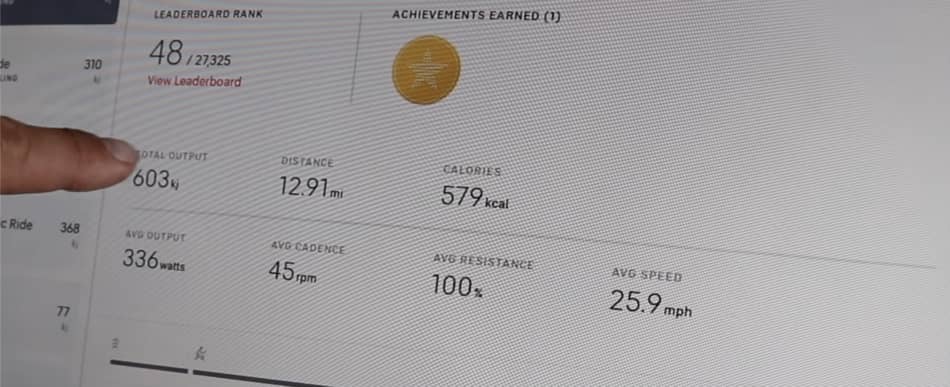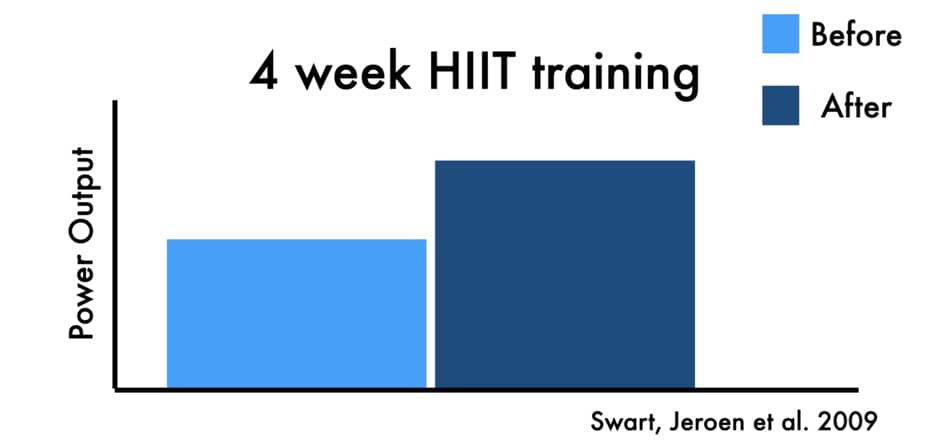In this article, I will explain if it’s easier for heavier people to have higher average power output on the peloton, and if so, what can you do to improve your numbers.
As a whole, peloton output is not based on weight. The power output is a measurement of the effort level produced during the training and it’s dependent on cadence and resistance. However, people with higher body weight will need to produce higher power output to move.
Keep reading to learn everything there is to know about power output and what practical things you can do to maximize your performance.

What Is Peloton Output?
Overall, the peloton power output is the measurement of how much work you did on average or in total during your ride. It is determined by the amount of energy transferred or converted per time. One unit of power is the watt, and it equals one joule per second.
In other words, peloton output works by giving you immediate and direct feedback on how hard you’re training.
The peloton bike can calculate how many watts have been produced on average, and per session.
Knowing your peloton output score helps you to track your results and implement progressive overload, where you gradually increase the intensity over the upcoming weeks.
It also helps you to calculate the number of calories you burn per class, as long as you update your profile on regular basis.
To learn “how accurate are peloton calories“, check out my article here.
How Does Peloton Output Work?
There are two types of “output” numbers that you will see on the peloton bike screen:
- Total output
- Average output
The total output gives you the number of kilojoules that you produced throughout the whole session. Think of this as the amount of energy you used in the whole class. This number will be higher, especially after longer endurance rides.
The average output is the number of watts that you produce in the current time. Think of this as the amount of energy that you used per second. This number will be significantly lower.
I know this is very confusing, especially if you compare your metrics with others because people often refer to their power output and use the total output as an indicator of their effort level, instead of average output.
Take a look at the picture below.

On the top, you can see the total output of 603 Kj. This is how much work I did over the 30-minute class. On the bottom (336 watts) you will see the average output I manage to maintain.
As you can see, there is a big difference between total output and average output. You can have the same average output for 20-minute and 60-minute rides. However, your total output will be three times higher for the longer session.
Why is my peloton output so low? As a whole, the peloton output can seem to be low when you compare it to others because several factors can affect your current performance. Those include rest, training intensity, and level of fitness.
Learn more: Click here to learn more on how to use “peloton total output” to track your progress.
Is Peloton Output Accurate?
As a whole, the peloton output accuracy is around 10% lower than the actual power that you produce. The output is based on the hall effect sensors that measure the speed and resistance of the flywheel. Those sensors signal the values to the touchscreen to calculate the number of watts generated.
NOTE: Keep in mind that the accuracy of both total output and average putout will require a properly calibrated bike. You can learn more about “peloton bike calibration” in my article here.
To put that into the perspective, regular power meters for road cycling bikes used by elite and recreational cyclists available on the market have 1.5% to 4% accuracy.
I think ten percent is a big difference, especially if you want to train for endurance events, and you need reliable output metrics. Compared to road bikes power meter, the peloton bike seems to be inaccurate.
That can be one reason why you find that output on the peloton is either too high or too low.
HOWEVER.
Most people who use peloton bikes (including me) are not gonna train for a triathlon. The majority of people are probably looking for a convenient way to be active, get stronger, and lose extra pounds.
For that purpose, even ten percent power output variance is good enough because it’s still more reliable than a heart rate monitor.
To be frank, I never had any issues with my output levels.
Peloton Output And Weight
Power output and body weight go hand in hand on peloton because heavier people need to generate more power to maintain the cadence and resistance. A higher weight means more energy is required to move the mass against the resistance.
As a result, this creates a higher power output score on the peloton bike. Your output will be higher on peloton if you weigh more, but also heavier people fatigue much faster because it is more difficult to sustain this effort.
One of my clients, Tom, lives near me and we often go on a cycling trip. He may be out of shape, but because he weighs 50 lbs more than me, he always can ride faster, especially on the flat road.
If you have two people going the same distance with the same intensity, the heavier person will generate a much higher output. However, this won’t last for too long.
Ideally, you want to increase the average power output and lower the bodyweight because this will give you more power and allow you to ride for longer.
In the cycling world, this is called the power-to-weight ratio.
What is the power-to-weight ratio? In general, the power to weight ratio is the amount of power that can be produced in relation to body weight. The power to weight ratio is expressed in watts per kilogram and is calculated by taking your power output and dividing it by your weight in kg.
For example, if your body weight is 155 lbs and your power output is 180 watts, your power to weight ratio is 2.6.
Below you can see the table with the calculated power to weight ratio using the formula watts/kg.
| Weight in KG | 100w | 130w | 160w | 190w | 220w | 250w | 280w | 310w |
|---|---|---|---|---|---|---|---|---|
| 50kg | 2 | 2.6 | 3.2 | 3.8 | 4.4 | 5 | 5.6 | 6.2 |
| 60kg | 1.7 | 2.1 | 2.6 | 3.1 | 3.6 | 4.1 | 4.6 | 5.1 |
| 70kg | 1.4 | 1.8 | 2.3 | 2.7 | 3.1 | 3.5 | 4 | 4.4 |
| 80kg | 1.25 | 1.6 | 2 | 2.3 | 2.75 | 3.1 | 3.5 | 3.8 |
| 90kg | 1.1 | 1.4 | 1.8 | 2.1 | 2.4 | 2.7 | 3.1 | 3.4 |
| 100kg | 1 | 1.3 | 1.6 | 1.9 | 2.2 | 2.5 | 2.8 | 3.1 |
| 110kg | 0.9 | 1.2 | 1.4 | 1.7 | 2 | 2.3 | 2.5 | 2.8 |
| 120kg | 0.8 | 1 | 1.3 | 1.6 | 1.8 | 2 | 2.3 | 2.5 |
What Is a Good Average Output For Peloton?
Overall, the good average output on peloton is around 150 to 250 watts. However, those numbers need to be adjusted by weight. If you take into consideration the body weight, this will be 3.0 for males and 2.0 for females using the power-to-weight ratio formula.
Also, this will depend on class duration because 20-minute rides will have a different average output, comparing to 75-minute rides.
The power-to-weight ratio matters the most in road cycling because if you can keep up high output while having lower body weight, you will need less effort to maintain speed and resistance for long-distance rides.
It makes long races less strenuous.
On the other hand, if you weigh more and you have to generate more energy to move, you will burn out quicker.
Is My Peloton Output Good?
I often see people use peloton output as a way to compete and compare themselves with others. This is a big mistake because you cannot control what power output other people have. The only thing you can control is your performance and training consistency.
Why is my peloton output getting worse? As a whole, there are several reasons why your peloton output is getting worse. This includes things like overtraining, poor sleep habits, not inefficient recovery, lack of good nutrition, or poor adherence to the training sessions.
So the question if your power output is good is subjective because everyone has unique predispositions and challenges that will determine their current power output on the peloton bike. Apart from weight, other factors will influence the number of watts you produce.
Also, please remember that peloton power output always changes as you train more. This is not a fixed feature, but a dynamic.
This means you can improve your output score if you train hard at the peak of your limits.
How To Improve Peloton Output
Overall, there are several ways you can do to improve your peloton power output score. These include adding more training volume (intensity and frequency), focusing on strength training, choosing longer rides, and paying attention to the nutrition and recovery practices.
#1 Focus on strength training
Doing weight training is good for the output because it increases the strength and makes it easier for the body to generate higher watts. Ideally, muscle groups should be trained at least two to three times a week to maximize muscle growth.
Does your lean weight affect peloton output? Overall, more lean body weight will positively affect your peloton output score because the bigger the muscle, the more force they can produce. Combination of strength training with endurance-cycling training can improve both short and long-term endurance performance.
I always find that regular gym workout allows me to gradually improve my peloton output score and avoid a plateau.
Not only that.
A study done by Dr. Christian Cook from Bangor University in the UK concluded that “Performing morning strength training is associated with improved physical performance in the afternoon.” (Cook et al. 2014).
They also showed that doing strength training in the morning elevates testosterone concentrations, which is a significant predictor of physical performance.
Normally, the T levels drop from morning to afternoon. However, doing resistance training in the morning seems to offset this decline.
This means if you want to get better output on the peloton, start your day from the strength training session and do your ride in the afternoon.
#2 Add more intensity
Doing high-intensity interval training rides is good for your peloton output score because it improves your overall performance. Training at an intensity above your lactate threshold improves your VO2 max and anaerobic capacity. This helps to maintain the higher effort for longer, without feeling fatigued.
Dr. Jeroen Swart from the University of Cape Town has documented the effect of high-intensity interval training on the group of trained cyclists.
- 4 weeks total
- 2 session per week

Each session lasts for just over 40 minutes (8 intervals of 4 minutes duration, with 90 seconds recovery time). The results showed a significant improvement in peak power output and 40-km time-trial performance (Swart et al. 2009).
NOTE: Please remember that you only need to do 1 to 2 HIIT rides per week to optimize your performance. For the rest of the week, you should focus on the duration.
#3 Take longer rides
Long-duration peloton rides are good for power output because they require significantly more effort to maintain high speed and resistance. This will help to build up the aerobic capacity and develop muscular endurance, as well as improve muscle perfusion and recovery.
What is a good Peloton output for 60 minutes? As a whole, the good peloton output for 60-minute rides is around 150 to 250 watts, depending on your stamina. Trained individuals can maintain higher output for significantly longer periods of time because they have higher lactate tolerance.
Higher effort for longer rides means that your muscles have to produce more lactic acid. This is where you feel that burning sensation in the muscles.
More endurance workouts leads to adaptations in both the cardiovascular and musculoskeletal systems:
- Increased mitochondrial biogenesis
- Optimal transport and use of oxygen to generate energy
- Delaying the onset of muscle fatigue
- Enhanced cardiac output
This will allow you to do more training volume with better power output. Please remember that the intensity of the class also plays a role. You don’t have to go hard with each workout.
My average power output for the 45-minute low-impact class is around 100 watts because this ride is not about going hard. This class is meant to be easy. On the other hand, with 20-minute interval rides, I can smash up to 300 watts without any problems.
What is a good peloton output for 20 minutes? Overall, the good power output for a 20-minute ride is between 200 to 300 watts. However, this will depend on the type of class you take. Low-impact rides are done with steady-pace calls for lower output, compared to HIIT and Tabata rides.
#4 Be patient and focus on performance
Peloton output and fitness level go neck and neck. Beginners will have a hard time maintaining higher output simply because their body is not accustomed to handling high intensity for a long time. Trained individuals can workout for harder and longer with less amount of effort.
What is a good peloton output for beginners? As a whole, the good average output for beginners on a peloton is around 50 to 150 watts. However, doing enough training volume and staying consistent quickly improves the aerobic capacity and allows to ride with higher resistance for longer.
When I started my journey with the peloton, my average power output was around 120 watts. And I only could maintain that pace for no more than 20 minutes. Now I can squeeze up to 330 watts but only for the 30-minute ride.
To put this into the perspective, some professional cyclists like Geoff Kabush can maintain the average output of 364 watts over a 200-mile ride. That is 12 to 15 hours.
#5 Track your macronutrients
In general, the macronutrient ratio is important for higher power output on peloton because carbohydrate intake promotes greater muscle glycogen content. This generates greater power output during training and enhances muscle recovery.
I know this can be hard to swallow, especially for people who seek weight loss and don’t want to eat carbs.
However, studies have shown that adding more carbs to the meals (10g per kilogram of body weight) increases overall power output by 10.7% (Simonsen et al. 1985).
However, this doesn’t mean you should be eating more carbs all the time. You can use the carb cycling technique, where you eat more carbohydrates on the hard workout days, and you lower carbs intake on the recovery days.
Another aspect of nutrition is a high amount of proteins to enhance rates of muscle protein synthesis, as well as fluid consumption during exercise to maintain hydration and thermoregulation.
Also, please remember that having a balanced diet helps to reduce excess weight, which helps to reduce pressure on the body and allows to do the harder work easier.
You can learn more on how to combine “diet and peloton” in my article here.
Conclusion
As you can see, the weight can affect the peloton output score. Extra body weight means the person needs to produce more energy to move around.
However, the ultimate goal is to improve your power-to-weight ratio. This means reducing excess weight and adding more power to your rides. This will help you to do the harder work easier and maintain the good effort for longer.
